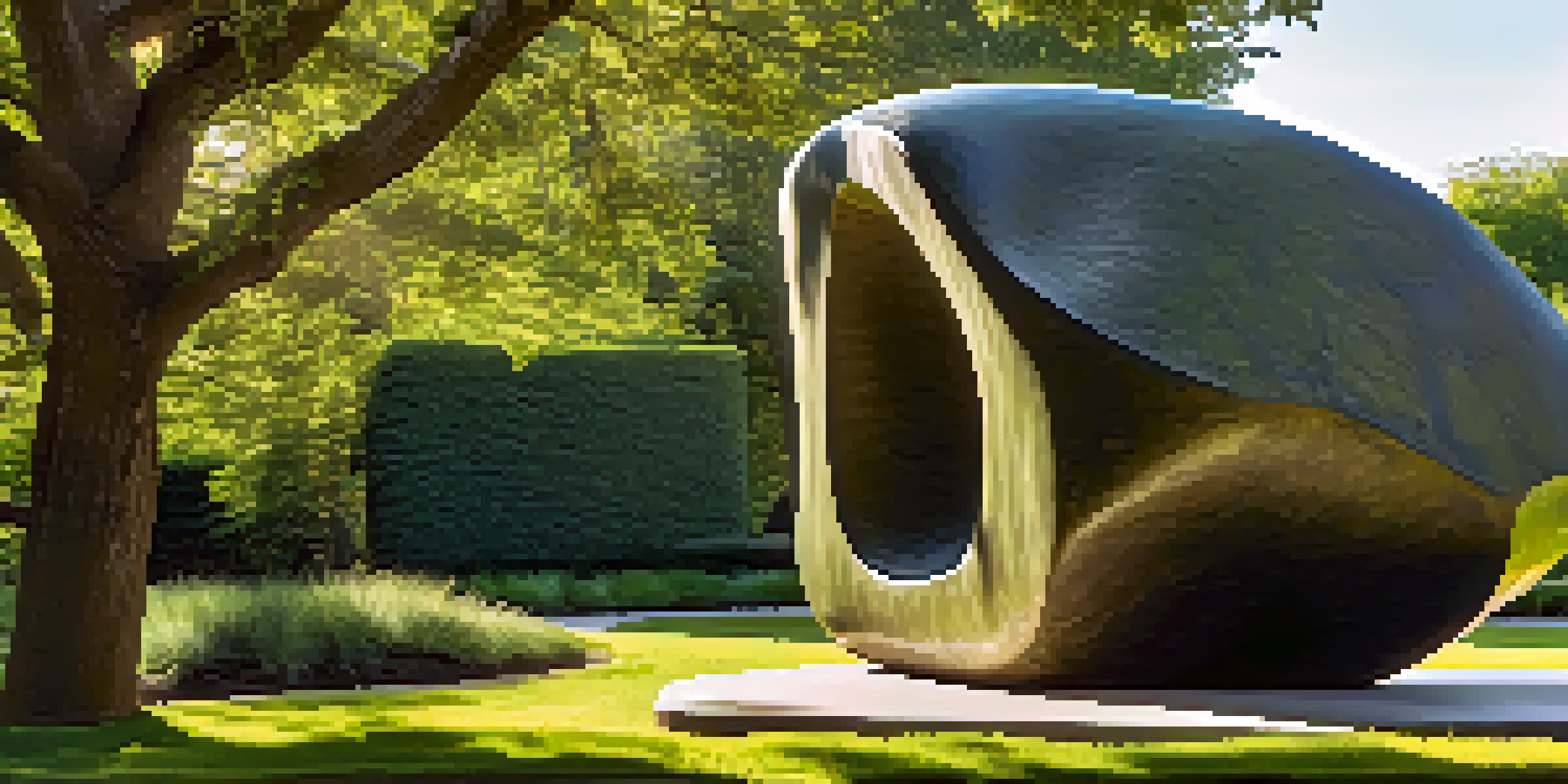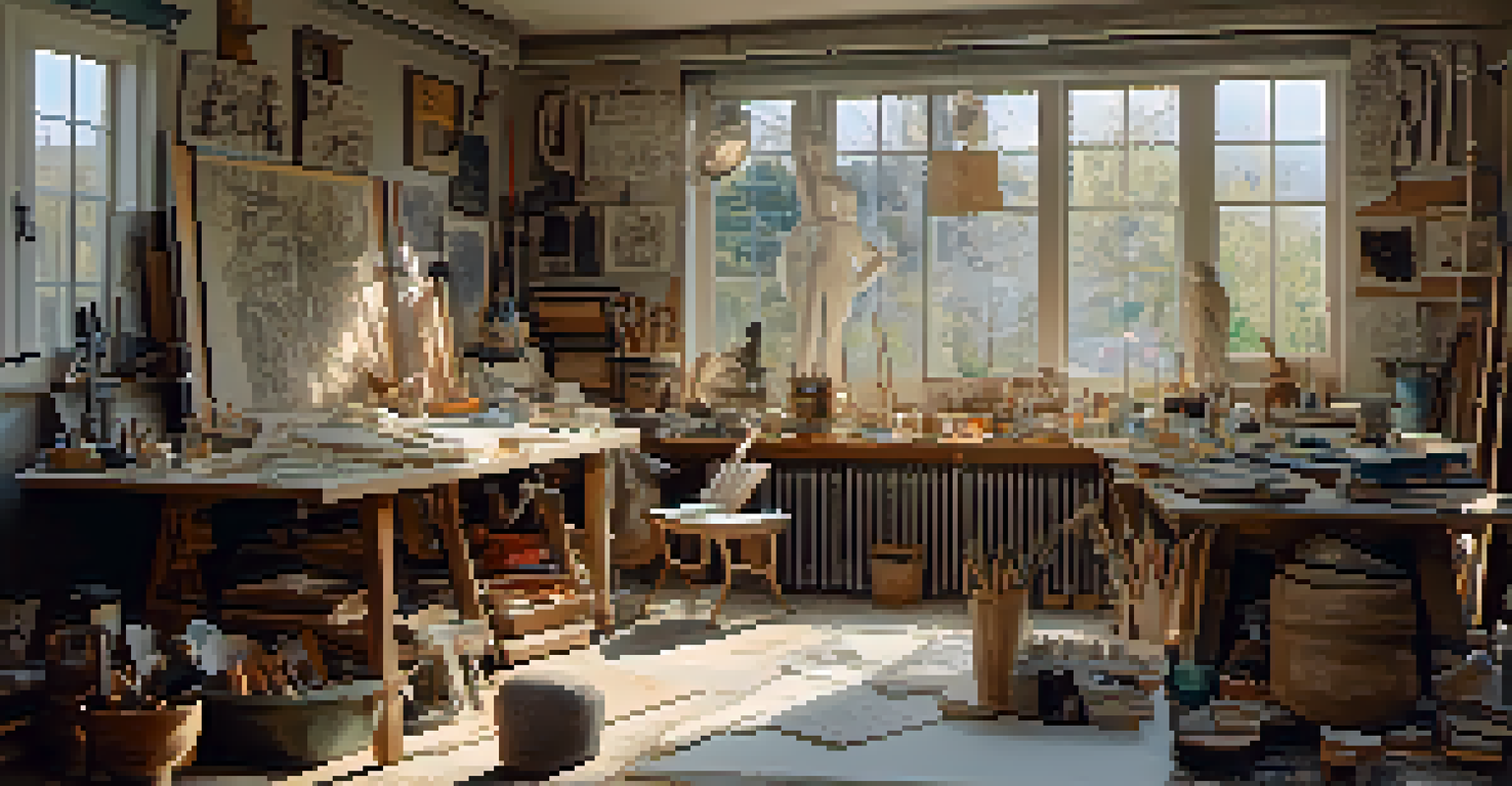The Evolution of Carving: Contributions of Henry Moore

Introduction to Henry Moore and His Impact on Carving
Henry Moore, a pivotal figure in 20th-century sculpture, is renowned for his innovative approach to carving. His works often blend abstraction with organic forms, creating a unique aesthetic that resonates with viewers. Moore's influence is seen not only in his sculptures but also in how he redefined traditional methods of carving in the art world.
The sculptor's mission is to make the invisible visible.
Born in 1898 in Castleford, England, Moore's artistic journey began during a time of significant social and technological change. This backdrop influenced his perspective, allowing him to experiment with various materials and techniques. His ability to adapt and evolve has left a lasting impact on future generations of artists.
Through his exploration of space and form, Moore challenged the conventions of sculpture. His works invite viewers to engage with them physically and emotionally, making them more than just static objects. This interactive quality is a hallmark of his contributions to the field of carving.
The Early Years: Influences on Moore's Carving Style
Moore's early experiences in the industrial landscapes of Yorkshire shaped his artistic vision. The natural elements intertwined with the remnants of industry inspired his use of organic shapes in his carvings. This connection between nature and human-made structures is a recurring theme in his work.

His education at the Leeds School of Art and later at the Royal College of Art exposed him to various artistic movements. Influences from ancient cultures and modernist tendencies pushed Moore to experiment with different styles and materials. This eclectic background laid the groundwork for his future innovations in carving.
Moore's Innovative Carving Techniques
Henry Moore's unique approach to carving, utilizing diverse materials and direct techniques, redefined the art form and inspired future generations.
Moreover, his exposure to the works of other artists, such as Picasso and primitive art, sparked his imagination. Moore's ability to synthesize these influences into his own distinct style is a testament to his creativity. Each carving tells a story, merging inspiration from the past with his contemporary vision.
Materials and Techniques: Moore's Innovative Approach
One of Moore's significant contributions to carving is his innovative use of materials. While many sculptors primarily worked with marble or bronze, Moore often embraced stone, wood, and even clay. This diversity in materials allowed him to explore textures and forms that were uniquely his own.
The best artist has no conception that a marble block does not contain the form; it is a piece of stone, and the sculptor must create something out of it, something which is an expression of the human condition.
His techniques also evolved throughout his career, blending traditional carving methods with modern practices. For instance, he often employed direct carving, which involves working from the material itself rather than relying on models. This hands-on approach fostered a more intuitive connection between the artist and his work.
Additionally, Moore's experimentation with scale set him apart from his contemporaries. He created massive outdoor sculptures that interacted with their surroundings, challenging perceptions of space. This integration of environment and sculpture is a hallmark of his legacy in the world of carving.
Themes in Moore's Carvings: Nature, Humanity, and Form
The recurring themes in Moore's work often revolve around the relationship between nature and humanity. Many of his carvings reflect organic shapes reminiscent of human figures, emphasizing the interconnectedness of life. This exploration of form invites viewers to consider their own place within the natural world.
Moore's fascination with the human body is evident in his sculptures, where he distills complex anatomy into simplified forms. By doing so, he captures the essence of humanity without being overly literal. This abstraction allows for a broader interpretation, making his work relatable to a diverse audience.
Themes of Nature and Humanity
Moore's sculptures frequently explore the interconnectedness of nature and humanity, inviting viewers to reflect on their relationship with the natural world.
Moreover, his use of negative space enhances the thematic depth of his carvings. The spaces between forms create a dialogue within the sculpture, encouraging viewers to engage with the work on multiple levels. This interplay of positive and negative space is central to understanding Moore's artistic vision.
Moore's Legacy: Influence on Contemporary Carving
Henry Moore's impact on contemporary carving is profound and far-reaching. His innovative techniques and thematic explorations have inspired countless artists to push the boundaries of sculpture. Many modern sculptors draw on his emphasis on organic forms and the interplay of materials and space.
Moreover, his ability to create large-scale public sculptures has redefined how art interacts with its environment. Today, artists continue to create works that invite public engagement, following in Moore's footsteps. This shift towards outdoor installations can be traced back to his pioneering spirit.
As we witness the evolution of carving in the art world, Moore's influence remains a guiding force. His legacy serves as a reminder of the importance of innovation and the exploration of new ideas in artistic expression. Through his work, he has paved the way for future generations of sculptors.
The Role of Education in Expanding Moore's Artistic Vision
Education played a crucial role in shaping Henry Moore's artistic vision. His time at various art institutions allowed him to explore different styles and techniques, fostering his creativity. This academic foundation enabled him to develop a unique approach to carving that combined tradition with innovation.
Moore's belief in the importance of art education is evident in his later life, as he became an advocate for promoting sculpture in schools. He understood that nurturing young talent is vital for the evolution of the art form. By sharing his knowledge, he inspired a new generation of artists to explore their creativity.
Enduring Legacy in Contemporary Art
Moore's influence on contemporary carving is evident as many modern artists continue to adopt his emphasis on organic forms and public engagement.
His dedication to education also extended to the establishment of the Henry Moore Foundation, which supports arts education and promotes sculpture. This commitment ensures that his legacy lives on, as future artists learn from his work and philosophy. Moore's influence continues to resonate within the art community, emphasizing the significance of education in artistic development.
Conclusion: Moore's Enduring Impact on the Art of Carving
In conclusion, Henry Moore's contributions to the art of carving are both significant and enduring. His innovative use of materials, along with his exploration of themes such as nature and humanity, has left an indelible mark on the sculpture world. Moore's ability to challenge conventions has paved the way for contemporary artists to think outside the box.
As we reflect on his legacy, it's clear that Moore's work transcends time and continues to inspire. His emphasis on interaction and engagement invites viewers to connect with art on a deeper level. This approach not only enriches the artistic experience but also fosters a greater appreciation for sculpture.

Ultimately, Henry Moore's journey as an artist exemplifies the power of creativity and innovation in carving. His influence will undoubtedly continue to shape the future of sculpture, reminding us that art is an ever-evolving dialogue between the artist, their materials, and the world around them.